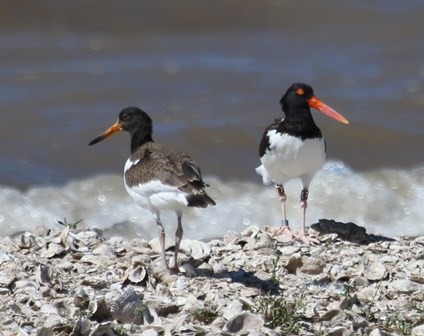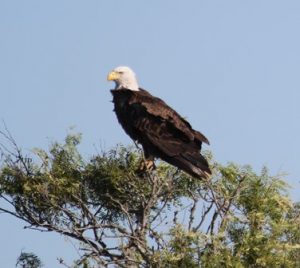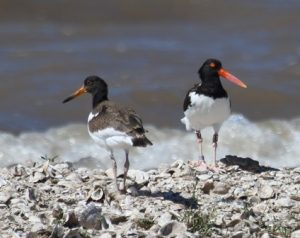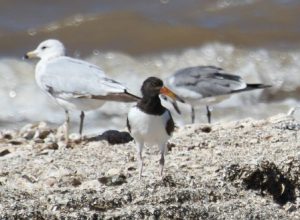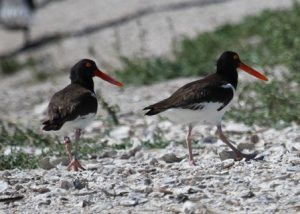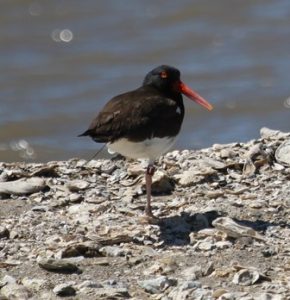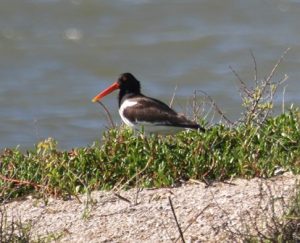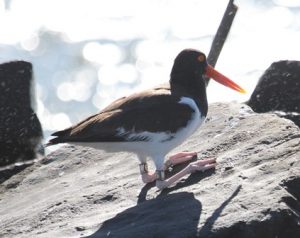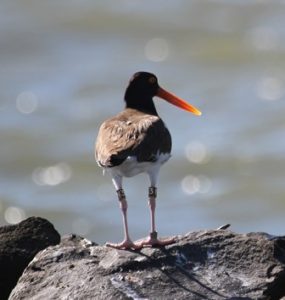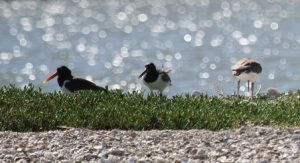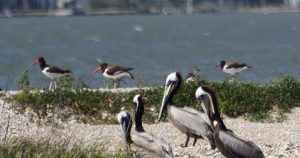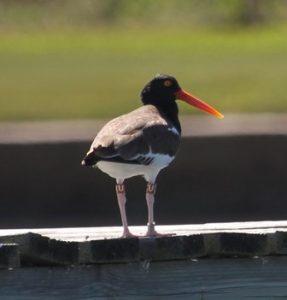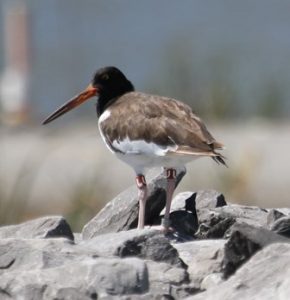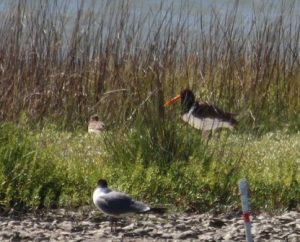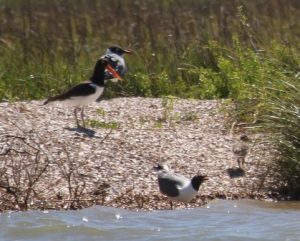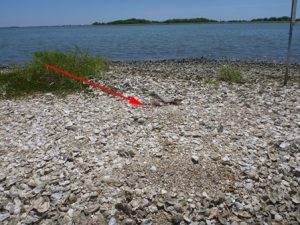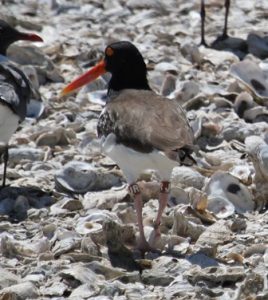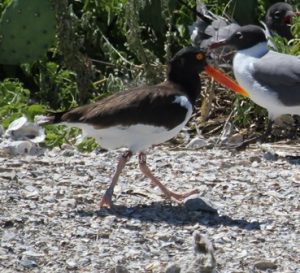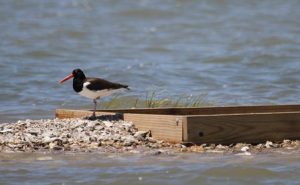By Susan Heath
I was able to get out East Matagorda Bay on Monday for the first time in a month. The last time I’d been out, one pair had two chicks and three pairs had nests, but the tide was really high and I feared the worst. I was joined by Jennifer Wilson, Texas Mid-Coast NWR biologist, and Woody Woodrow from the U.S. Fish and Wildlife Service Coastal Program. We did the route in reverse because the wind was stronger than predicted and we didn’t have to fight it as much that way. On the way down the GIWW we spotted this magnificent beast.
We checked on ER & unbanded and found them loafing on their scrap of an island with no nest and no chicks. I feel for this pair. There is probably no way they can be successful there.
When we got to Old Gulf Cut we found that the pair that had two chicks, 17 & unbanded, still had two chicks and they were fledged! That was happy news.
We headed over to the Oyster Farm to check on the pairs there. The pair we banded last time wasn’t present. KM & unbanded were loafing on their island without any chicks so their nest must have failed.
KT was all alone on his island. His mate was probably over on the beach feeding. I forgot to bring the receiver so we couldn’t check if his nanotag is still transmitting but we could see the antenna from it sticking out so we knew it was still on him.
We headed over to Dressing Point and Woody explained some of the restoration that is going to happen there. This island is about ¼ the size it used to be due to erosion and there is a big restoration planned with oil spill money. They are going to build breakwater around it and back fill with dredge spoil to restore the island but they are also going to build a ½ acre shell island at one end. That will provide some much needed nesting habitat for oystercatchers! I can’t wait to see that happen. The birds in this bay really need help.
We checked on the last pairs near Chinquapin and found only one of them present with no nest. So all the nests failed and there are no new ones. It’s fabulous that 17 & unbanded fledged their chicks though. They were one of the early nesters (we found their nest in February) and it is always the case that the early nesters do better.
On Tuesday, I was joined by John Wright and Davis Clay to survey the pairs in West Galveston Bay. Alan Wilde was off on vacation in Belize (lucky Alan!) and Davis agreed to step in boat tender. We made our usual route and discovered the wind had taken its toll here too. Up in Swan Lake, I have no idea what’s happening with K7 & unbanded. It seems clear their nest failed but they don’t seem to have a new one like I thought. If they do, it is well hidden which wouldn’t surprise me a bit! W6 & N3 and 39 & L5 nests both failed as they weren’t incubating anymore and the eggs were gone. It didn’t seem like they overwashed so it was probably predation of some sort. R5 & X3 must still have chicks though because they were up in the vegetation protecting them.
We checked the breakwater on our way out because the oystercatchers really like to hang out there when they aren’t tending a nest or chicks. We found W6 and N3 there. W6 was laying down and clearly did not want to be bothered with me waving my arms at him to get him to stand up. This was the best he could offer!
His mate N3 was a little more accommodating.
We headed back down to West Galveston Bay and checked on the birds on Struve Luci. L8 & L9 were still incubating their nest. It looked like HM & unbanded decided to make a nest on a rock wall where they tried to nest last year too. It’s not a good spot and they will likely get predated by a mammal but we will wish them the best. I didn’t take a photo but will try to get one next week. 12 & unbanded were hanging out on the shell ridge and one of K6 & JA was with the fledged chicks U0Y and U4X. U4X’s nanotag was still transmitting too.
Over on Jigsaw I was elated to find that T5 & T6’s chick U3Y had made it through another week. One more week and it will be fledged!
A check of LH’s nanotag showed that it was still transmitting. He and his mate WW were walking along the shell ridge and we didn’t see any chicks with them so their nest may have failed.
We found XU on the one of the docks along Sportsman Road. XU is 12 & unbanded’s chick from 2014 and was banded in April of that year on Struve Luci.
Then on the new Gangs Bayou breakwater we found LU who was one of the last chicks to be banded last year. He/she was reared on Jigsaw Island.
On the Gangs Bayou island we saw an adult fly in with food to the first unbanded pair there so we know they have at least one chick though we did not see any. The next pair down has had two chicks for a couple of weeks now. Today we only saw one but the other one was probably there too.
We headed over to South Deer and discovered the KK & unbanded’s nest had failed as they were loafing along the shoreline. KK has a nanotag so I broke out the receiver to see if it was still working. They conveniently flew over us just as I got it set up and I picked up the signal without having to walk down the island to get closer to them.
LL’s unbanded mate was hanging out along the shoreline with their chick.
The rest of the pairs there were a bit of a mixed bag. Several of them should have chicks but we didn’t see any so we don’t know their status. We will have to keep watching them. We headed over to North Deer and Marker 52 and found that J6 & UF’s nest had overwashed in the strong winds last weekend. I was afraid this was going to be the case. Their island is so low that they just don’t stand much of a chance.
On North Deer we discovered not only JR but also JH. This is quite strange. Someone turned in photos of what appears to be JR with a chick on Evia Island in East Galveston Bay. I mentioned this last week. Alan is going to go check that area out when he gets back from vacation but now JR is back on North Deer which is totally weird. Even weirder is that JH was with him. JH was JR’s mate for several years but she disappeared last year and has not been seen since January 2017. What the heck is going on with these birds!
We continued our monitoring and discovered that JJ & P4’s nest had failed as they were standing along the shoreline nowhere near where it had been. Shucks. I had high hopes for that one. 23 & WY were loafing along the shoreline of their territory. Remember that – it comes up again in a minute! H0 & JC were standing up on a shell ridge with no apparent chicks so their nest probably failed too. Thank you Laughing Gulls. It appears 28 & AP’s nest met the same fate.
Our last stop was to check the pairs in the Jones Bay. Sadly we found that P3’s & unbanded’s nest had overwashed again (third time this year). CA & unbanded were on the breakwater around the Tiki spoil unit but so was WY (I told you to remember – remember?). I was scratching my head over that because we had just seen WY over on another island in his/her nesting territory. What the heck was it doing over in Jones Bay? Then we found FR hanging out next to the nesting platform the Master Naturalists built for him.
There was another oystercatcher there and I assumed it was Y2, FR’s mate but it wasn’t. It was 23, WY’s mate! So apparently 23 & WY flew over to Jones Bay from Marker 52 while we were making our way over there ourselves. These birds have wings and they know how to use them! Sometimes I think they are purposely trying to confuse me but I am probably the least of their worries!
Current Stats for upper Texas coast from Dickinson Bay to East Matagorda Bay: 3 nests being incubated, 32 failed nests, 7 nests with unfledged chicks, 6 nests with undetermined status, 4 chicks fledged
This project is supported by the National Fish and Wildlife Foundation and several private donors. If you would like to contribute you can do so by clicking on the Donate Now button below. All donations are tax deductible and GREATLY appreciated.

